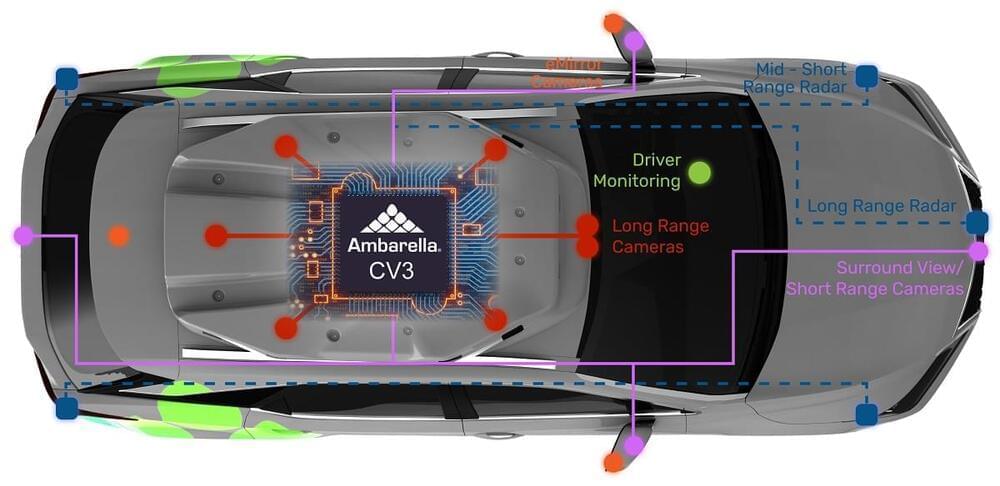A JEFF BEZOS-linked firm “dedicated to reversing the ageing process” could open a lab in a quiet rural English village, Express.co.uk can reveal.


From the cosmic microwave background to Feynman diagrams — what are the underlying rules that work to create patterns of action, force and consequence that make up our universe?
Brian’s new book “Ten Patterns That Explain the Universe” is available now: https://geni.us/clegg.
Watch the Q&A: https://youtu.be/RZB95znAGRE
Brian Clegg will explore the phenomena that make up the very fabric of our world by examining ten essential sequenced systems. From diagrams that show the deep relationships between space and time to the quantum behaviours that rule the way that matter and light interact, Brian will show how these patterns provide a unique view of the physical world and its fundamental workings.
Brian Clegg was born in Rochdale, Lancashire, UK, and attended the Manchester Grammar School, then read Natural Sciences (specialising in experimental physics) at Cambridge University. After graduating, he spent a year at Lancaster University where he gained a second MA in Operational Research, a discipline developed during the Second World War to apply mathematics and probability to warfare and since widely applied to business problem solving. Brian now concentrates on writing popular science books, with topics ranging from infinity to ‘how to build a time machine.’ He has also written regular columns, features and reviews for numerous magazines and newspapers, including Nature, BBC Focus, BBC History, Good Housekeeping, The Times, The Observer, Playboy, The Wall Street Journal and Physics World.
This talk was recorded on 28 September 2021.
–
A very special thank you to our Patreon supporters who help make these videos happen, especially:
Supalak Foong, efkinel lo, Abdelkhalek Ayad, Martin Paull, Ben Wynne-Simmons, Ivo Danihelka, Hamza, Paulina Barren, Kevin Winoto, Jonathan Killin, János Fekete, Mehdi Razavi, Mark Barden, Taylor Hornby, Rasiel Suarez, Stephan Giersche, William ‘Billy’ Robillard, Scott Edwardsen, Jeffrey Schweitzer, Gou Ranon, Christina Baum, Frances Dunne, jonas.app, Tim Karr, Adam Leos, Michelle J. Zamarron, Fairleigh McGill, Alan Latteri, David Crowner, Matt Townsend, Anonymous, Robert Reinecke, Paul Brown, Lasse T. Stendan, David Schick, Joe Godenzi, Dave Ostler, Osian Gwyn Williams, David Lindo, Roger Baker, Greg Nagel, and Rebecca Pan.
–
Subscribe for regular science videos: http://bit.ly/RiSubscRibe.

Ambarella launched its latest CV3 AI domain controller family to power autonomous vehicles.
The Santa Clara, California-based maker of AI chips made the announcement at the CES 2022 tech trade event in Las Vegas.
The chip family is another addition to the scalable, power-efficient CVflow family of system-on-chips for the automotive industry.

A high-tech lab in Nanjing in the eastern Jiangsu province of China has claimed that it has made a breakthrough in next-generation communications technology, South China Morning Post reported. The lab was working on a special government project on 6G technology in association with Fudan University and the nation’s telecom giant, China Mobile.
The world is yet to see the potential of 5G and how it could change our world. Although the low latency and high transmission speeds are notable features of the technology, there does not appear to be a common world application that could put this technology to use en-masse. The high deployment costs of the technology have also put a dampener on its rollout, with operators opting for a slow pace until usage really picks up, SCMP reported.
This hasn’t, however, perturbed the engineers’ desire to build the next big thing. Last year, we reported how LG Electronics was working on ushering in the 6G of wireless communication and how China had already deployed a 6G capable satellite back in 2020. The problem, however, is that there is no standard that has been accepted to define what 6G constitutes.
COUNTDOWN TO RELEASE: Here comes the next and final installment in The Cybernetic Theory of Mind series ― The Omega Singularity: Universal Mind & The Fractal Multiverse ― which is now available to pre-order as a Kindle eBook on Amazon. In this final book of the series, we discuss a number of perspectives on quantum cosmology, computational physics, theosophy and eschatology. How could dimensionality be transcended yet again? What is the fractal multiverse? What is the ultimate destiny of our universe? Why does it matter to us? What is the Omega Singularity? These are some of the questions addressed in this concluding volume of my eBook series.
#OmegaSingularity #UniversalMind #FractalMultiverse #CyberneticTheoryofMind #EvolutionaryCybernetics #PhilosophyofMind #QuantumCosmology #ComputationalPhysics #futurism #posthumanism #cybernetics #cosmology #physics #philosophy #theosophy #consciousness #ontology #eschatology
This final book V of The Cybernetic Theory of Mind series is an admittedly highly speculative theoretical work where we’ll be testing the limits of our imagination envisioning the prospects of our distant future and the deepest secrets of hyperreality. In our fractal, computational Omniverse (all multiversal structure combined, all that is) one may assume that an infinitely large number of civilizational minds, syntellects, have followed or will follow a path, similar to ours, in their evolutionary processes. At the highest level of existence and perceptual experience, that we can rightfully call ‘Dimensionality of Hypermind’, universal minds would form some sort of multiversal network of minds, layer after layer seemingly ad infinitum.
The Cybernetic Theory of Mind series is a collection of books by evolutionary cyberneticist and philosopher Alex M. Vikoulov on the ultimate nature of reality, consciousness, the physics of time, computational physics, philosophy of mind, foundations of quantum physics, the technological singularity, transhumanism, posthumanism, the impending phase transition of humanity, the simulation hypothesis, economic theory, the extended Gaia theory, transcendental metaphysics and God. If you’re eager to familiarize with probably the most advanced ontological framework to date or if you’re already familiar with the Syntellect Hypothesis which, with this series, is now presented to you as the full-fledged Cybernetic Theory of Mind, you should get this book five of the series which corresponds to Part V of The Syntellect Hypothesis: Five Paradigms of the Mind’s Evolution.


Our gut microbiome helps us out every day by processing the fiber we can’t digest. The bacteria ferment the fiber into key chemicals known as short-chain fatty acids, or SCFAs, that are essential for human health. SCFAs fight inflammation, help kill dangerous bacteria, protect the lining of the gut, and can even help prevent cancer.
In a new study, the John Denu lab at the University of Wisconsin-Madison’s Wisconsin Institute for Discovery has learned that the fatty acids butyrate and propionate also activate p300, a crucial human enzyme that promotes the unspooling of DNA. This unwound DNA allows more genes to become active and expressed, which ultimately affects human health.
A study by Wisconsin Institute for Discovery researchers challenges long-held beliefs, with potential implications for physiological processes and diseases such as propionic acidemia, autism spectrum disorder and Alzheimer’s disease.

Down syndrome is the most common genetic disorder, impacting about 1 in 700 newborns around the world. At some point during their first hours and days of embryonic development, their dividing cells fail to properly wriggle a chromosome pair away from each other, leaving an extra copy where it shouldn’t be. Although scientists have known for more than six decades that this extra copy of chromosome 21 causes the cognitive impairment people with Down syndrome experience, exactly how it happens remains a matter of debate.
But in recent years, scientists using new RNA sequencing techniques to study cells from pairs of twins — one with Down syndrome and one without — have repeatedly turned up a curious pattern. It wasn’t just the genes on chromosome 21 that had been cranked way up in individuals with Down syndrome. Across every chromosome, gene expression had gone haywire. Something else was going on.
On Thursday, a team from the Massachusetts Institute of Technology reported in Cell Stem Cell that it may have found a surprising culprit: senescent cells, the same types implicated in many diseases of aging. The study was small and preliminary, and some experts want to see it replicated in samples from more individuals before buying into its interpretations. But they are nevertheless intriguing.

At the touch of a button, the car changes colors.
The surface coating of the BMW iX Flow featuring E Ink contains many millions of microcapsules, with a diameter equivalent to the thickness of a human hair. Each of these microcapsules contains negatively charged white pigments and positively charged black pigments. Depending on the chosen setting, stimulation by means of an electrical field causes either the white or the black pigments to collect at the surface of the microcapsule, giving the car body the desired shade.
Just don’t expect to see this at your local BMW dealership anytime soon: the automaker says this is just an “advanced research and design project.”
The innovative paint scheme can be triggered at the touch of a button. Right now, the colors are limited to white, black, and grey. But despite the constrained palette, BMW says it could have implications for the efficiency of its electric vehicles.

Even though solid state batteries are seen as technology that could drastically improve today’s fully-electric vehicles, it seems the first vehicles to feature one won’t actually be EVs. This is at least true in Toyota’s case since the manufacturer has now confirmed that its first solid state-equipped vehicles will be hybrids expected to debut in two or three years’ time.
The news comes from Gill Pratt, Toyota’s chief scientist and head of the Toyota Research Institute, who made the announcement during an interview for Autoline. He also mentioned that the manufacturer has made progress with its solid state project and that development is on schedule.
He did not say which hybrid Toyota will get a solid state battery, but he did go on to explain why it won’t immediately offer solid state EVs. The main reason has to do with the size of the battery pack, which for a hybrid vehicle that still has an internal combustion engine, is considerably smaller than what you see in pure EVs.